Ko Lanta is a culturally interesting island in that it is inhabited by three distinct groups of people; Sea Gypsies, Thai-Muslims and Thai-Chinese. I was staying in the Old Town on the quieter East Coast of the island, where Chinese New year celebrations were ongoing and you are woken early by the call to prayer. The call drifts across the murky tidal waters that lap under the stilted wooden houses and upon which fishing boats bob up and down on the grey sea.
A few kilometres down the road, the Muslim community of Tung Yee Peng, have established an eco-tourism centre. From this tiny hamlet built on the edge of the mangroves, you can explore the river and forests by boat. A dusty lane takes you over a concrete bridge and then a precarious climb down a very steep ladder-type structure onto a platform where it is best to just stand still so you don’t fall into the river through the gaps in the planks. When I had seen the words Eco-Tourism Centre I was imagining a modern building and lots of information about ecology etc. But there was absolutely nothing like that here, which actually was much nicer and more interesting.
The Eco-Tourism Centre, Tung Yee Peng
You are then helped onto a kayak and pushed away from the boarding. No life-jacket, no safety regulations, rules or information at all. But a guide from the community paddled alongside and in our pair of bright pink and red kayaks we made our way down the olive-green river. I was briefly reminded of a scene from Apocalypse Now.
The mangrove river
The river is dark, broad and deathly still. Either side of the water, there are grey mud flats at the top of which the impenetrable, tangled mass of mangrove forest awaits; so dark you cannot see even a few feet within. At first it all seems lifeless, being completely silent and very serene. But as we row closer to the river bank, the guide points out the many crabs that are crawling around in the mud and the more you look, the more different sizes and colours of crab you can see: bright turquoise, orange, ochre yellow. They shift around in the squelching sludge and occasionally appear to be squabbling over food or burrows or perhaps mates. I had many questions for the guide but he spoke very little English, so we lapsed into a pleasant silence, he occasionally pointing out this and that as we went along, possibly shrimps, oysters and all sorts of other interesting creatures. The community here get their main income from fishing and tourism and in the far distance where the river widened into the sea, we could see fishermen collecting crabs on the muddy shores.
Fishing and crabbing in Tung Yee Peng
As we rowed up a brackish tributary, we were able to get closer to the trees. Most of them appear to be Rhizophoras. I believe they were Rhizophora apiculata (commonly known as Bakau Minyak). There may also have been R. mucronata or R. mangle (Red Mangrove). Rhizophoras all have aerial prop-roots which anchor the plant to the soil to help them withstand the large waves, rough tides and storms that batter these waters. They also have stilt roots which grow down from the base of the stem, which as well as being another anchor, also take up water and nutrients. Their multiple roots resembled strange legs to me and it looked like they were gradually creeping down into the river or engaged in a silent dance with the crabs in the mud.
The aerial prop roots of Rhizophora apiculata
Like many mangrove plants, Rhizophora have ultrafiltration mechanisms which not only reduce the impact upon the plants of the high levels of salt in the sea water, but they also help increase the quality of the water. They are very useful plants to the community here too who use their wood for producing charcoal, and for the construction of boats and buildings. The bark of these trees can be used for leather tanning, and for extracting ethanol. I have also read that it is an antidote to dysentery-type symptoms which could have been useful to me this week; I have been laid low for the past few days by some hideous illness; fever, dreadful headaches, diarrhea and fatigue, and have barely been able to get out of bed. The joys of travelling in Asia I suppose! But on the mend now and at least able to write this today.
Back to the river, as we made our way along, the guide pointed out some strange wriggling creatures which he says are walking fish. It was hard to see them clearly at first, as they are either the colour of mud, or covered in mud; I initially thought that they must be some sort of reptile. But no they are fish and they are legless the guide tells me. They appear to shift themselves along, in a very ungainly but effective fashion, by using their front fins as legs and propelling themselves by their tails. One would suddenly jump out of a hole in the mud and wriggle it’s way forward before disappearing down another burrow. I look them up later; known as mudskippers, (due to their supposed skipping movement), they have frog-like faces with bulging eyes on the top of their heads.
When you are on the water it is hard to identify what other trees are growing amongst the Rhizophoras in the dark, dense forest. However, some days after my visit to Tung Yee Peng, I went to the Mangrove Research Centre in Rayong. Again I was expecting something very different than what I found, but I was certainly not disappointed. This research centre is a long stilted walkway through the mangroves on the riverside south of the city. It takes an hour or two to do the whole walk and you can get up close to the plants. There is no fee, no information in English and no one around to whom you can ask questions, but some of the plants were botanically labelled which in itself gave me plenty to research.
The Mangrove Research Centre, Rayong
There was Bruguiera gymnorhiza (Large Leaved Orange Mangrove) which like many of these plants, have exposed knee roots. The specific name illustrates this, gymno meaning naked and rhizo - roots. There is also Avicennia alba, the very fast growing mangrove tree with white flowers, thus alba. There was Xylocarpus granatum growing there, the cannonball mangrove due to it’s large round fruit; and Finlaysonia obovata which is a woody climber found exclusively in mangroves. One that stood out was Nypa fruticans (the Nipa Palm) which is the only palm adapted to mangroves. The trunk of this palm grows under the water and only the leaves, which can grow up to 9 meters, project upwards.
Nipa Palm (centre) with Rhizophora mangle (Red Mangrove) each side, Rayong
I am sure that some of these other trees would have been growing in the mangrove forest in Tung Yee Peng too, but I can’t say that I was able to identify them when I was there. In any event, my focus on plants was distracted by crabs, walking fish and then monkeys that appeared at the edge of the forest. Before I knew it, one jumped in the river and swam over to join the guide on his kayak. The guide then threw a piece of pineapple to me and the monkey followed, adeptly swimming and then happily leaping on to my boat, finding the fruit and munching away as we slowly continued down the river.
On the Tung Yee Peng river
Suddenly there were monkeys everywhere to be seen in the forest clambering in the trees and looking over at us. I wondered if we were going to be inundated. Indeed several made the journey and swam over, one of whom rested it’s delicate long-fingered hands on my knee as I paddled. They seem to know and understand the guide well, who engaged in funny chat with them.
Pregnant monkey on my kayak
It was hard to know what else was in the river; I was thinking crocodiles, although I later learned that the Siamese crocodile is sadly one of the world’s most endangered reptiles and so I assume none were in there. But occasionally there would be a sudden disturbance and a few large fish, tails twisting, would leap out of the water and flail around for a few seconds before throwing themselves back in again causing a big commotion.
Mangroves are super effective at soaking up carbon dioxide and other greenhouse gases, and they can store ten times the amount of an average forest. This makes them about the most carbon-rich tropical forests in the world. They also act as a great habitat for all sorts of fauna; fish, crustaceans and birds. Whilst I didn’t manage to get any decent pictures of a walking fish, I did manage to get a slightly blurry snap of a Collared Kingfisher on the Rayong Mangrove walkway, where they were in their element, swooping and diving.
Collared Kingfisher in The Mangrove Research Centre, Rayong
These very small projects therefore, in Ko Lanta and in Rayong, are absolutely vital for protecting these special trees and whilst both are advertised as tourist attractions, they are extremely quiet and so no one could say that they have been ruined by visitors. Hopefully the work will continue in both places to protect these lovely and quite magical forests.




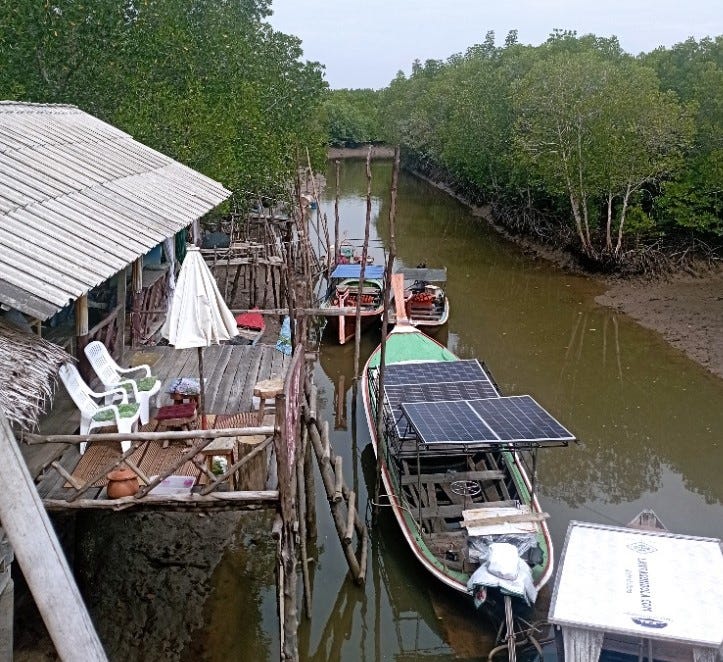
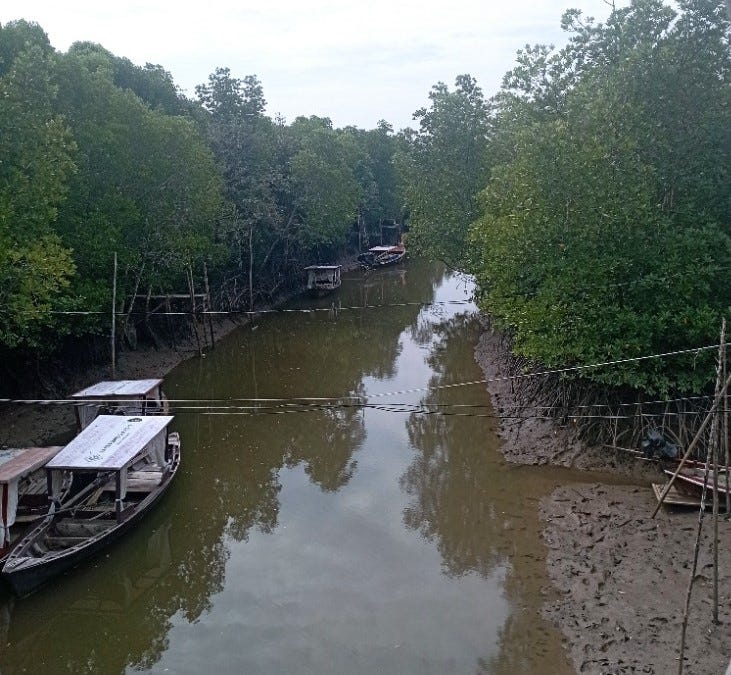
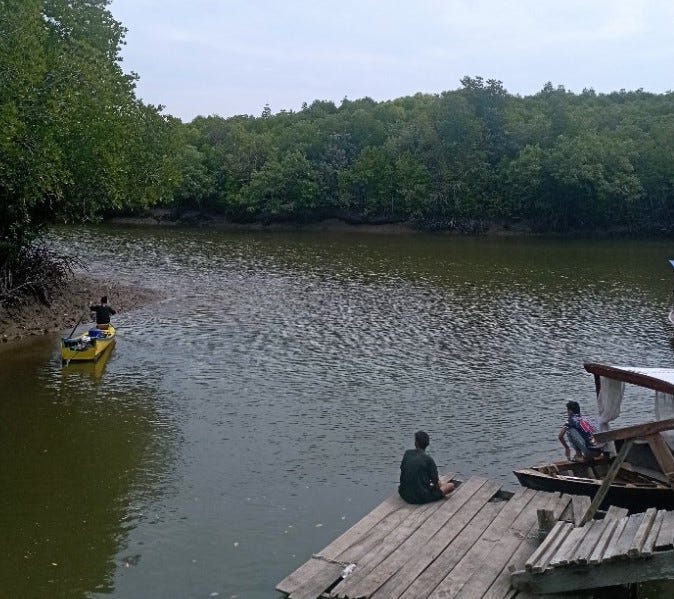
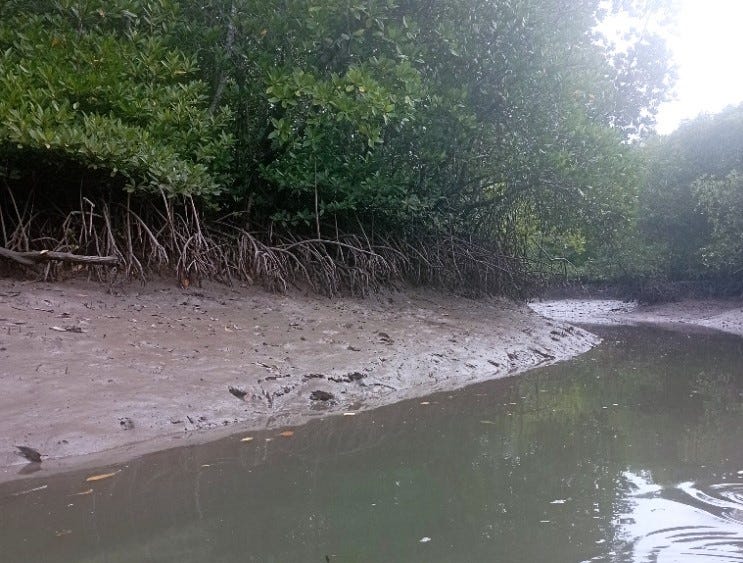


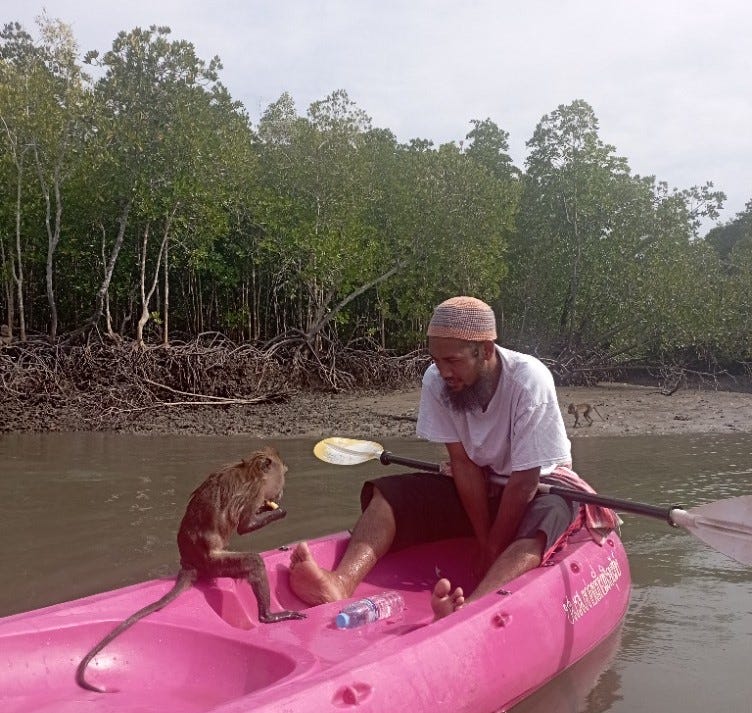
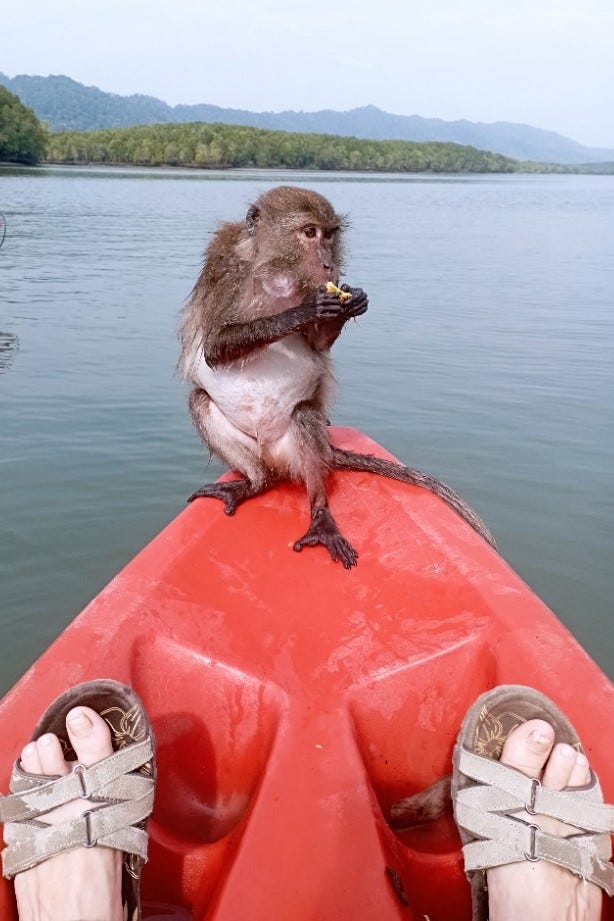

Yes mangroves are interesting aren't they. And thank you, yes, I am definitely on the mend now. Hope to be up and about and back to normal (whatever that is) tomorrow.
Very informative and interesting. Glad to hear you're recovering from such a nasty feverish sickness